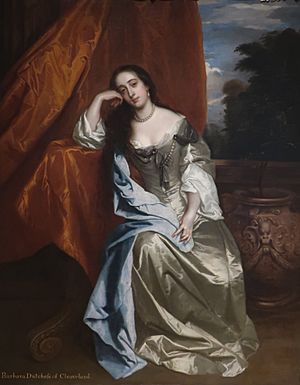Roger Palmer, 1st Earl of Castlemaine facts for kids

Roger Palmer, 1st Earl of Castlemaine (1634–1705) was an important English figure. He worked for the king as a courtier and diplomat. He was also a writer and, for a short time in 1660, a member of the English Parliament. Roger Palmer was a strong supporter of the Roman Catholic faith. His wife, Barbara Villiers, was a well-known figure at the court of King Charles II.
Contents
Early Life and Education
Roger Palmer was born into a Catholic family in 1634. His father, Sir James Palmer, worked for King Charles I. Roger grew up at Dorney Court in Buckinghamshire.
He received a good education, attending Eton College and King's College, Cambridge. Later, he studied law at the Inner Temple in London. In March 1660, Roger Palmer was chosen to represent Windsor in the English Parliament.
Marriage and Royal Connections
In 1659, Roger Palmer married Barbara Villiers. A year later, in 1660, his wife Barbara became very close to King Charles II. The King decided to give Roger Palmer a special title. In 1661, he was made Baron Limerick and Earl of Castlemaine.
However, this title was unusual. It was meant only for any sons he might have with Barbara. This showed everyone at court that the honor was given because of Barbara's connection to the King. Roger Palmer did not want the title under these conditions, but it was given to him anyway. He never took his place in the Irish House of Lords, even though he used the title.
Public Service and Faith
Roger Palmer was a very loyal supporter of the Stuart kings. He also openly practiced his Roman Catholic faith, even though it was difficult and sometimes dangerous to do so in England at that time.
Serving Abroad
In 1664, Roger Palmer traveled through France and Italy. During this time, he served as an officer in the navy of the Venetian Republic. He returned to England later that year. In 1665, he served in the Royal Navy under the Duke of York during a war with the Dutch.
Facing Challenges
Because he was a well-known Catholic, Roger Palmer faced difficulties. During a time of strong anti-Catholic feelings, he was suspected of being involved in a plot against the King. He was sent to the Tower of London and later put on trial for treason. He defended himself in court and was found not guilty.
Diplomatic Role
When James II became king in 1686, Roger Palmer became a member of the King's special advisory group, the Privy Council. He was then appointed as the Ambassador to the Vatican City. In this role, he worked to support King James's plans.
Later Life and Legacy
After the Revolution of 1688, when King James II lost his throne, Roger Palmer had to flee. He was arrested and sent to the Tower of London several times between 1689 and 1696. Each time, he was eventually released.
Roger Palmer passed away peacefully in Oswestry in 1705 at the age of 70. He was buried in the Herbert family vault in Welshpool. His wife, Barbara, died four years later. Roger Palmer's titles ended when he died because he had no sons with Barbara.
He was also a writer. Some of his works include Catholique Apology (1666) and The Earl of Castlemaine's Manifesto (1681).
Family Life
Roger Palmer married Barbara Villiers on April 14, 1659. His family was not happy about the marriage.
Barbara had several children. Her first daughter, Lady Anne Palmer, was born in February 1660. A son named Charles was born in June 1662. Most of Barbara's children were later recognized by King Charles II.


